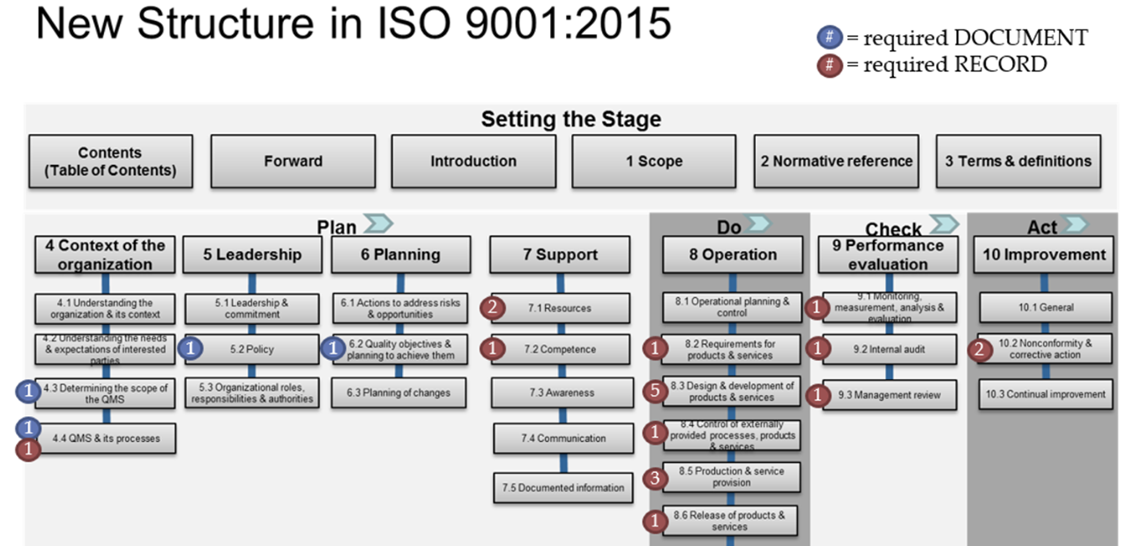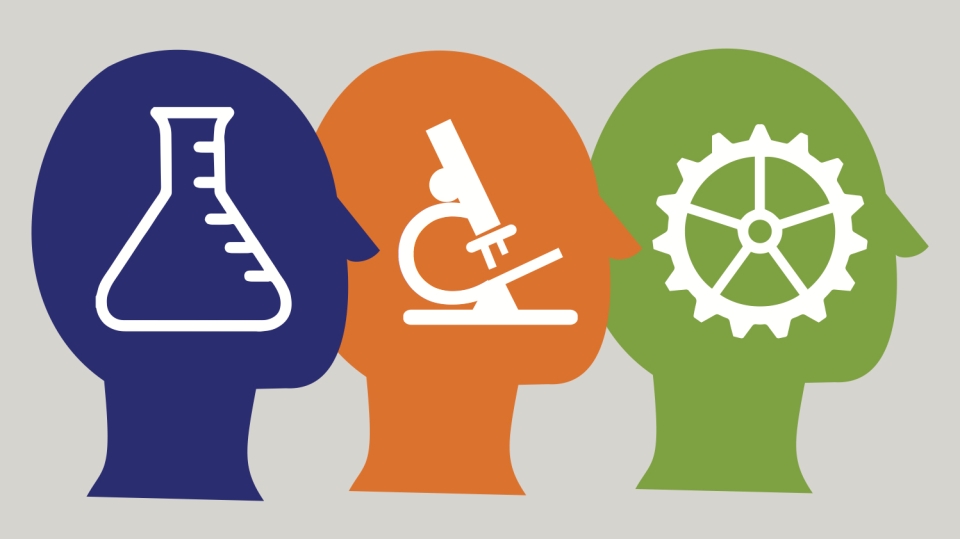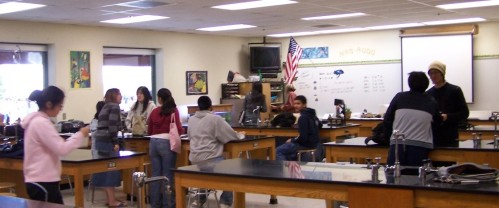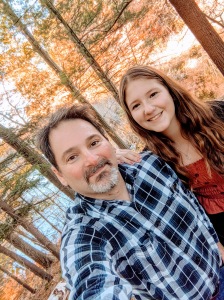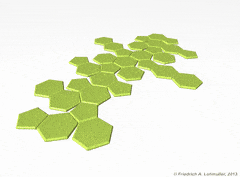Home » Posts tagged 'pedagogy'
Tag Archives: pedagogy
How can we use the ISO process to help improve schools?
Many companies use ISO processes to systematically look at and improve their company. School districts and individual schools can benefit from the same ISO process. You can learn more about ISO here. This flowchart shows the structure of ISO 9001, and below we show it can be used in schools
Context of the organization
For a business – how is it organized? What is their QMS (quality management system?)
For a school – how is the school system organized? It usually looks something like this:
City or town school committee -> Superintendent -> School district teams and Principals -> Each individual school teacher and staff structure.
What kind of QMS do we find in schools?
Each school collects data on grades, attendance, safety, college or trade school or career acceptance, etc. They send this data to the appropriate district teams for discussion and analysis. This information should be made available to the school committee and general public.
Leadership
For a business, what are the leadership levels? They often look like:
President -> Vice president -> Department managers -> Employees within each department.
For a school, what are the leadership levels?
Principal -> assistant principals or deans ->teachers and paraprofessionals -> Students
Planning
For a business, what are the objectives and how does it achieve the objectives?
For a school, what are the objectives and how does it achieve the objectives? They may include:
* Promote a safe environment both for teachers and students
* Promote college and/or career readiness
* Develop young women and men into confident, self-directed, lifelong learners
* Develop young women and men to become productive members of their community
Support
For businesses – Resources, awareness, communication, documented information.
For schools –
Resources: Most classes have rooms with sufficient chairs and desks, bookshelves, supplies, manipulatives, lab equipment, textbooks (whether physical or digital;) computers/Chromebooks; school library, etc. Similarly, we can define what resources should be available for music, art, physical education, vocational education, special education, English Language Learners education, etc.
Awareness – There should be a structure for both teachers and students to have their concerns and needs heard by the administration.
Communication – Teachers communicate in regular department meetings and through email. The school has meetings for department heads for cross-curricular issues. There are whole-school meetings for all faculty/staff.
Documented information – This includes, but is not limited to, textbooks, teacher texts, worksheets, sample essays, quizzes, exams, labs, etc. (physical or digital,) and the district’s official learning standards (which may be local, state, national, or a combination thereof.)
Operations
For a business, we clearly define the production and delivery of products/services.
For a school we clearly define the creation/revision of pacing guides and lesson plans; and the implantation of these in the classroom, music room, art room, gym, etc.
Performance evaluation
For businesses: Is the product being made correctly? Monitoring, measurement, analysis, evaluation, internal audit. Management review.
For schools – Informal discussions, and asking questions, with students throughout the day. School quizzes and tests. State or national mandated standardized exams.
Improvement
For businesses – Identify any nonconformities and then decide what corrective actions would be helpful. A goal is continual improvement.
For schools – The parallel to nonconformities in schools could include –
– a student demonstrating that they didn’t (yet) learn certain facts; haven’t (yet) understood how individual facts were related in a greater whole; or haven’t (yet) mastered certain skills.
– a teacher demonstrating that they didn’t (yet) master how to create/revise pacing guides and lesson plans, or (yet) fully implement classroom management skills.
– an administrator demonstrating that they didn’t (yet) master how to help new or struggling teachers, how to help teachers who may feel targeted by students or parents, how to help students who have learning problems, how to help teachers or students who may be experiencing discrimination, etc.
and then decide what corrective actions would be helpful. The goal is continual improvement.
How to prepare for teaching AP Physics
So you have been assigned to teach a high school AP Physics class, congratulations! Teaching this or any AP high school science can be a fun, rewarding experience. There are ways to make it easier for new AP teachers coming into our schools. But if we don’t take such steps then we may set teachers up for failure. So here’s specific advice for those who have been asked to teach AP Physics for the first time:
* Have your school sign you up for an AP physics summer institute. Every high school should pay for this – and they should pay not only for the class, but also travel expenses, and room & board. The amount of money is peanuts compared to the school annual budget, and they know it. It is a one-time expense to create excellence for a program that impact many students for many years.
* Spend a few weeks talking with teachers who’ve taught AP physics before. They will be happy to share their notes with you. With their help, create a month-by-month pacing guide. As the year progresses try to stick with it so you get through all of the material.
* At the beginning of each unit/month, break your pacing guide down into a day-by-day pacing guide.
* Before the first day of school – get into the physics stockroom. Get into the online file/document storage, the bookshelves, and any storage cabinets that they have in the physics classrooms.
* Work with the teachers and science department head to find all the AP physics labs that AP physics students in your school have previously have been doing.
In theory, all of that should already be there for you, plug and play. But in reality many science department heads are overwhelmed, and have not made sure that this was done. In some schools when I walked in there was almost nothing organized for me. Many files were on somebody else’s hard drive or cloud drive, and those that were available were not always well organized or explained. Lab supplies were not always well organized or labeled.
* Plan ahead: You should try to run a couple of AP labs each month.
* Spend time – ideally, before the school year begins – going through the physics lab supply room. Find all items necessary to do the labs. For those items that you cannot find, work with your department head to write a purchase order to get what you need.
This can be a very doable job if there was good organization in the year before. There’s no reason for any school to not already have, for every new teacher walking in the door:
* A month by month, week by week AP pacing guide
* A good textbook or set of online resources that each lesson connects to
* Appropriate, well-labeled, and well-documented, AP physics labs.
* Clear lab write-ups for the teacher and for the students.
The challenges that we face are:
* Some people were disorganized. Their files may be in disarray.
* Some people create a detailed curriculum but take it with them and leave nothing for the new teacher. That shouldn’t be happening, we’re supposed to be a community where we all support and value each other.
* Some people lose parts/ lab supplies, don’t tell anyone, and don’t order replacement parts. That sets the next teacher up for frustration.
How we grow: One of the things I worked on over the years is showing my materials to teachers and students, and improving my process from their reactions. Sometimes what I wrote seems clear to me, yet someone will point out something ambiguous. This gives me an opportunity to rewrite and make things clearer.
Most problems for the next incoming AP science teachers go away as long as, in the previous year, the department head sits down with the science teachers and works things out ahead of time. Good intentions and a recognition that we are all part of a community leads to good organization and improvement of pedagogy. This benefits the entire community.
How do we plan a science class for topics left out by the NGSS?
What do we do when try to align a physics unit with NGSS – and NGSS doesn’t have anything on the topic?! For instance, NGSS seems to leave out: kinematics, vectors, parabolic motion, fluids, buoyancy, electrical circuits, rotational motion, geometric optics, and simple machines.
The official explanation is that NGSS standards are more about skills than content. That would be fair – except they do list specific content for so many other things. So what can we do?
We tie the physics topics that we teach into the NGSS in three ways:
(A) We teach students how to do problem solving in this unit. We address the NGSS problem solving and critical thinking skills.
(B ) Look into the NGSS Evidence statements. These offer many examples. Many of these evidence statements do specifically cover what we are looking for.
(C) We teach students how to do problem solving in this unit and cite the relevant, related Common Core Math standards that are addressed by this.
___________________________________
Thanks for visiting my website. We also have resources here for teachers of Astronomy, Biology, Chemistry, Earth Science, Physics, Diversity and Inclusion in STEM, and connections with reading, books, TV, and film. At this next link you can find all of my products at Teachers Pay Teachers, including free downloads – KaiserScience TpT resources
Which pedagogical strategy is best?
Anurag Katyal offers a great answer to this question!
Lectures work great, except when they don’t. Active Learning works great, except when it doesn’t. Just In Time teaching works great, except when it doesn’t. There’s no silver bullet. Context always matters.
Lectures work better for PhD students because they already have well defined boxes of knowledge in their head that they can file new information in. Younger students don’t have this and that’s why it doesn’t work nearly as well for them, yet it’s wrong to say it doesn’t work at all.
Active learning is fantastic for extroverted self-assured students who are up for the challenge. It doesn’t work as well for those who are painfully shy.
Just in time teaching works well for those who have some background already but need a reminder. You can’t do just in time remediation for factoring when a group of students does not know how to add signed numbers.
Context from day to day matters just as much – are you teaching at an independent school where a chipped nail is a crisis or at an underfunded public school in the inner city where kids don’t know where they will sleep that night.
Some techniques might work well in one school but not the other. You certainly can’t flip a classroom and have students watch YouTube videos ahead of class if they don’t have running water at home, let alone an internet connection. Well, you can try but it won’t go too well.
In my own classes, I find myself starting with inquiry as the highest ideal – and then going down the active learning scale based on the mood in the room on any given day. Sometimes, I have to go all the way to the bottom and lecture.
Sometimes, students pull me aside and say thanks for lecturing that day because xyz happened and they just would not have been a good group member. Other days, those students might be the first at the board.
Forget all the snazzy names and acronyms. Don’t let a pedagogy become your identity. Read the room. Adapt. Teach in a manner that will be best received that day. Remain flexible. Every 5 years, some new acronym comes out that’s the latest and greatest thing since sliced bread when all the students really wanted that day was a PBJ…
A master list of pedagodies/startegies:
Pedagogical strategies
Pedagogical theory
Bloom’s Taxonomy: Use and misuse
Bloom’s Taxonomy: Thinking well requires knowing facts (content and skills)
Levels – Levels of high school science classes
Honors – Why schools should offer Honors classes
Learning new information relies on having already existing knowledge.
Maslow’s hierarchy of needs – claims and reality
Students need to engage in internal mental reflection
Thinking well requires knowing facts
Tier I, II and III vocabulary
Learning styles and multiple intelligences
Reframing the Mind. Howard Gardner and the theory of multiple intelligences, By Daniel T. Willingham
Self esteem and students
Articles by cognitive scientist Daniel Willingham
Writing skills
One page notes/posters
Note taking skills
Good writing and avoiding plagiarism
How to write a physics lab report
Developing writing skills: Verb wheel
___________________
Thanks for visiting my website. We also have resources here for teachers of Astronomy, Biology, Chemistry, Earth Science, Physics, Diversity and Inclusion in STEM, and connections with reading, books, TV, and film. At this next link you can find all of my products at Teachers Pay Teachers, including free downloads – KaiserScience TpT resources
Spiral curriculum
Allan House writes
A spiral curriculum better matches with current understanding of how language is learned. Language can’t be broken down into discrete blocks which are independently masterable, revision is key to mastering items and skills and new vocabulary, learners will not truly learn a grammar point they are not ready for. They will only master a grammar form [or any topic] when they are at the right point in their learning. The repetition inherent in a spiral curriculum better allows for the above.
Learners come in with differing levels of language mastery, and jagged learning profiles. With a linear curriculum they may have missed some points which won’t be covered again. A spiral curriculum allows for revision of previously covered points, which also allows those with gaps to catch up in areas they are weaker in.
Robert Kaiser writes
Here is a visualization of linear learning. Each month, each year, we cover certain topics. In this lineal model we don’t come back to those topics again as time passes by. Rather, as time goes by we cover only new topics. The implicit assumptions here are:
* that everyone really learns – and learns well – the material the first time that they are exposed to it
* When learned encounter new material, they remember and understand the older material that this newer material depends on.
Yet good teachers understand that both of these assumptions are wrong.
For any topic in science (and also history, and ELA) students should instead cover content and skills in a spiraling fashion: They would start by being introduced to basic ideas in elementary school, at a level appropriate to their comprehension levels at the time.
Students must then be reintroduced to most of the same ideas in middle school, yet now at a deeper level. This time with more nuance, more facts. For some topics, with more mathematics. More sophisticated examples and more discussions. During this time we now include new topics that weren’t covered previously.
For those students taking high school classes, such as physics, chemistry, mathematics, they again should cover the same topics, but this time with more math, a richer set of examples, and of course newer material. Here is a visualization of how a spiral curriculum works:
Here is another such visualization.
As science teachers in high school we often have no control over elementary and middle school education, and often even little or no say in the overall curriculum of our own high schools. But if people would just listen to us teachers then they’d know we have a better way to teach science over time, this kind of teaching.
Thanks for visiting my website. We also have resources here for teachers of Astronomy, Biology, Chemistry, Earth Science, Physics, Diversity and Inclusion in STEM, and connections with reading, books, TV, and film. At this next link you can find all of my products at Teachers Pay Teachers, including free downloads – KaiserScience TpT resources
Levels of high school science classes
Most high schools offer several levels of many of their science classes.
Honors – More rigorous, aimed at students with interests in STEM careers or top tier colleges. They provide an intellectual challenge and opportunity. Some honors classes go at a faster pace, covering more topics over the course of a year. Others follow the same pace as regular classes but in more depth.
College Prep – Aimed at most students in the school. These are meant to challenge and grow students intellectually.
Foundations – For students on a lower academic level or for those doing well in other subjects yet who have issues with mathematics. This level focuses on applications and big ideas.
Foundations classes shouldn’t be confused with SPED. That being said, they could be a great opportunity for SPED inclusion. This level is variously known as (for example)
* Foundations of {physics} * Conceptual {physics} * Applied {physics}
* Fundamental {physics} * {Physics} in the community * Introductory {physics}
Advanced Placement – Many schools offer a higher level science class in the following year, Advanced Placement or IB (International Baccalaureate.)
Some caution – one shouldn’t replace Honors classes with AP. I would hate to throw a student with no physics background straight into an AP Physics class. I would want them to have a year of honors or college prep physics first.
Integrated science classes – Many schools offer integrated subjects, such as:
Physical Science – combining elements of chemistry and physics, with examples of applications to biology, for instance.
General Science- combining elements of many different science topics.
________________________
Thanks for visiting my website. We also have resources here for teachers of Astronomy, Biology, Chemistry, Earth Science, Physics, Diversity and Inclusion in STEM, and connections with reading, books, TV, and film. At this next link you can find all of my products at Teachers Pay Teachers, including free downloads – KaiserScience TpT resources
One-page notes/posters
Idea: Students show what they learn by creating a large, colorful single page poster with graphics and text. Why? One-pagers are visually attractive; help students organize their thoughts; give students an opportunity to show originality & creativity.
Materials: Large pieces of paper (art pads/newsprint pads.) e.g. 18”x12” or 18”x24”; colored pencils, markers, pastels, pens, etc.
Who this project typically appeals to: Students comfortable with art. They want to create their own unique layout and drawings from scratch. Challenges: Some students don’t feel comfortable with their artistic skills. These students will benefit from us providing templates to choose from.
This kind of project will be new to many students: we need to show them a few examples.
Rubrics/parameters (possible ideas)
English Language Arts/Literature
• Create a drawing or icon which represents the theme.
• Create a sketch (or decoupage a photo) showing the setting (location/time period.) Have a couple of sentences describing this.
• Include quotations
• Describe main characters; info about a character arc.
• Describe themes; questions that the author is asking us; responses.
• Write something that they personally connected with.
History/Social Studies
• Create a drawing or icon which represents the theme.
• Make connections between the text and current events
• Create a sketch (or decoupage a photo) showing the setting (location/time period.) Have a couple of sentences describing this.
• Include quotations from related primary sources.
• Examine several historical figures in this unit and their impact on history
• Write something that they personally connected with.
Science
• Create a drawing or icon which represents the main ideas
• If about the discovery of a law of physics or chemistry, create a sketch (or decoupage a photo) showing the setting (location/time period.) Have a couple of sentences describing this.
• Relevant equations
• Examples of how this scientific principle operates in the real world.
External resources
We Are Teachers – One-pager-examples ELA
cultofpedagogy.com – One pagers
Colonialsd.instructure – Sample instructions and rubric
Alvord Schools – Sample one pager instructions (PDF)
Thanks for visiting my website. We also have resources here for teachers of Astronomy, Biology, Chemistry, Earth Science, Physics, Diversity and Inclusion in STEM, and connections with reading, books, TV, and film. At this next link you can find all of my products at Teachers Pay Teachers, including free downloads – KaiserScience TpT resources
Learning Standards
Common Core ELA Science
CCSS.ELA-LITERACY.RST.9-10.2
Determine the central ideas or conclusions of a text; trace the text’s explanation or depiction of a complex process, phenomenon, or concept; provide an accurate summary of the text.
CCSS.ELA-LITERACY.RST.9-10.7
Translate quantitative or technical information expressed in words in a text into visual form (e.g., a table or chart) and translate information expressed visually or mathematically (e.g., in an equation) into words.
NGSS Science and Engineering Practices
Obtaining, Evaluating, and Communicating Information
Communicate scientific and technical information (e.g., about the process of development and the design and performance of a proposed process or system) in multiple formats (including oral, graphical, textual and mathematical).
NGSS Evidence Statements – Observable features of the student performance by the end of the course: Students use at least two different formats (including oral, graphical, textual and mathematical) to communicate scientific and technical information, including fully describing the structure, properties, and design of the chosen material(s). Students cite the origin of the information as appropriate.
Essential Knowledge and Skills Statements (ESS)
National Association of State Directors of Career and Technical Education Consortium (NASDCTEc) 2008
Communications: Use oral and written communication skills in creating, expressing and
interpreting information and ideas including technical terminology and information.
Pacing guide for year long Physics course
A pacing guide helps us decide what we’re going to cover over the course of a year. I especially find it helpful to set one up as a week-by-week plan.
Pacing guides are important structures to help us stay on track throughout the year; this is important for several reasons. In some school districts your students may need to pass a state exam in physics such as the MTEL or Regents. Some students want the opportunity to go onto AP Physics, or to major in a STEM subject in college. They are best served with a rich curriculum covering many important areas.
Yet a pacing guide is not scripture. The needs of students will vary from district to district, from year to year. Sometimes you have exceptionally well-prepared students who already know some of the material covered below. Other years you may have a class that wasn’t as well prepared in their middle school years; they find even the basic concepts very challenging.
A pacing guide is made for us teachers and our students. It shows we are doing in class each week; it can be as detailed as showing what we are doing each day. The guide is about ideas and content, not about administration.
Pacing guides tell us – what ideas are we covering today/ What phenomenon will we investigate? What labs or manipulatives will we use? What videos, GIFs, or infographics will we use? What equations will we introduce? Basically – you as the teacher decide – “What do I need to know, to walk into that classroom feeling fully prepared?”
Lesson plans tell us: what the “do now” is; what the skills and vocabulary goals are; what pedagogical methods the teacher will be using; what learning standards the lesson addresses. They are often designed in great detail; they vary significantly from district to district. In private conversations most teachers have told me that they don’t find school-demanded lesson plans to be very useful. Teachers might spend an hour a day or more on these; and then, over the course of our careers, they need to be totally rewritten in new formats when new trends develop.
Sometime later this month I will be placing a useful and detailed pacing guide for sale on Teachers Pay Teachers. Stay tuned.
– Robert Kaiser
Teaching three dimensional geometry in high school
Most school districts still make students master a one-size-fits all sequence of geometry topics and skills that is largely unchanged since the 1800s. Does this inspire students to love math, become mathematicians, engineers, or physicists? Does it provide the mathematical literacy necessary for people to function in society?
The endless system of curriculum reforms over the last century (*) hasn’t helped achieve either goal. Some students do fall in love with math and science, but usually in spite of curriculums, not because of them.
School districts are pressured to have standardized state exams. Some pressure is from parents who think that good education means doing it the same way that it always has been done. (And to be sure, it is important to have mastery of some basic geometry topics.) Yet most pressure is from politicians. How? Textbook publishing companies give campaign donations to politicians; they want them to enact a constant stream of new curricula so they can sell new learning materials and tests. Students are stuck in a system in which the voices of expert math and science teachers are minimized.
How does this issue relate to geometry in specific? Students are relentlessly drilled on two dimensional geometry, and how to construct proofs. Many students dread this; they find it disconnected from daily life, devoid of fun, and not instilling any sense of wonder.
Yet when we talk to actual mathematicians we learn that they they investigate interesting and fun problems in geometry; they find almost mystical connections between the laws of math and laws of the universe itself; and they use geometry not in two dimensions, but in three.
They use geometry for engineering and building; machining and 3D printing parts, metalwork, and tools; they use 3D polygon design for computer programming and making video games.
Where is all of this in our schools? It is time to listen to math teachers, mathematicians, and people who use these ideas for work or art. We should reduce the amount of time we spend on geometry proofs, and increase the use of fun, interesting and practical 3D geometry.
– Robert Kaiser
(*) Left Back: A Century of Battles over School Reform, Diane Ravitch
Presented below is an example of transforming two dimensional geometry into three dimensional geometry, which has applications in sports, engineering, and videogames.
First, consider regular, convex polygons Mathsisfun.com Regular polygons
Here are the basic regular and irregular polygons.
Now consider shapes in three dimensions: A polyhedron (plural polyhedra or polyhedrons) is a 3D shape with flat polygonal faces, straight edges and sharp corners or vertices.
The five convex examples have been known since antiquity and are called the Platonic solids:
The triangular pyramid or tetrahedron, cube, octahedron, dodecahedron and icosahedron:
Look at 2D pentagons and hexagons – consider: Do they tile together without gaps or overlaps?
If so then show us…. But if not then how can we get such tiles to fit tightly without overlap or gaps?
We need to assemble them together into a 3D structure. What do we mean by 3 dimensional?
Questions: How many tiles of each type will we need? How do we arrange them? Is there more than way to do this, or just one way?
Procedure
Give students hexagon and pentagon templates (on heavy card stock.)
They will trace multiple copies of each one onto card stock or construction paper.
Carefully cut out all of these pieces. Assemble them together into a 3D structure with a regular, repeating pattern. The resulting shape should have no gaps or overlap.
How do we use geometry in real life
Geometry in real life: careers and at home
Related readings
The (Math) Problem With Pentagons.
“Three pentagons at a vertex gives us 324 degrees, which leaves a gap of 36 degrees that is too small to fill with another pentagon. And four pentagons at a point produces unwanted overlap. No matter how we arrange them, we’ll never get pentagons to snugly match up around a vertex with no gap and no overlap. This means the regular pentagon admits no monohedral, edge-to-edge tiling of the plane.”
The (Math) Problem With Pentagons. Triangles fit effortlessly together, as do squares. When it comes to pentagons, what gives? Patrick Honner, Quanta Magazine, 12/11/2017
Two-Dimensional Math In a Three-Dimensional World, Marjorie Senechal & George Fleck, Education Week, 2/6/1985
Week Five: Make Something Big, Daniel B. Rosenberg
Building a buckyball, PBS NOVA
Thanks for visiting my website. We have resources for teachers of Astronomy, Biology, Chemistry, Earth Science, Physics, Diversity and Inclusion in STEM, and connections with reading, books, TV, and film. At this next link are some great resources at Teachers Pay Teachers, including free downloads – KaiserScience TpT resources
Learning Standards
Common Core Math – Geometric Measurement and Dimension
• Explain volume formulas and use them to solve problems
• Visualize relationships between two-dimensional and three-dimensional objects
CCSS.MATH.CONTENT.HSG.MG.A.3
Apply geometric methods to solve design problems (e.g., designing an object or structure to satisfy physical constraints or minimize cost; working with typographic grid systems based on ratios).*
Appendix A Common Core Math, Unit 3: Extending to Three Dimensions
Visualize the relation between two dimensional and three-dimensional objects.
Apply geometric concepts in modeling situations.
National Council of Teachers of Mathematics, Standards and Positions
Grades 9–12 Expectations: In grades 9–12 each and every student should – Analyze properties and determine attributes of two- and three-dimensional objects; Explore relationships (including congruence and similarity) among classes of two- and three-dimensional geometric objects, make and test conjectures about them, and solve problems involving them.
Ecology and Biology in Science Fiction
Ecology and Biology in Science Fiction
Copyright 1996, 1997, 1998, 1999, 2000 by Magic Dragon Multimedia. All rights reserved Worldwide. May not be reproduced without permission. May be posted electronically provided that it is transmitted unaltered, in its entirety, and without charge.
We examine both works of fiction and important contemporaneous works on non-fiction which set the context for ecological Science Fiction and Fantasy. Some questions that we study include:
- How do living organisms grow and reproduce? (Tribbles, TV: Star Trek)
- What forces shape the evolution of species, including our own? Could humans evolve into something very different? (novel: Galapagos, by Kurt Vonnegut)
- What kind of planet is needed for living things and ecosystems to evolve? (novel: Red Mars, by Kim Stanley Robinson)
- What would a desert planet look like? (novel: Dune, by Frank Herbert)
- How does genetics create us–and recreate living things? (novel: Jurassic Park, by Michael Crichton)
- Could genetics make us immortal? (novel: The Children Star, by Joan Slonczewski)
- What if an alien invader tried to do us in–from within? (novel: Andromeda Strain, by Michael Crichton)
- What if the aliens decide they like us–too well? (novel: Dawn, by Octavia Butler)
Biology in Science Fiction: Syllabus by Prof. Joan Slonczewski. Prof. Joan Slonczewski describes her required reading list as follows (the hotlink shows the color art for each book):
- Barlowe’s Guide to Extraterrestrials, by Wayne Douglas Barlowe [New York: Workman Publishers, 1979] “In his classic guide, Wayne Douglas Barlowe’s brilliant portraits bring to life 50 aliens from science fiction literature: Larry Niven’s Thrint and his Puppeteer, Arthur C. Clarke’s Overlord, Frank Herbert’s Steersman, Robert Silverburg’s Sulidor and more. Humanoids, insectoids, reptillians-even protoplasmic, gaseous, and crystalline life forms-are all faithfully and naturalistically depicted so that you can now visualize what could only before be imagined.”
- The Time Machine, by H.G. Wells [New York: Bantam Books, 1895] “When the Time Traveler courageously stepped out of his machine for the first time, he found himself in the year 802,700 — and everything had changed. In another, more utopian age, creatures seemed to dwell together in perfect harmony. The Time Traveler thought he could study these marvelous beings — unearth their secret and then return to his own time-until he discovered that his invention, his only avenue of escape, had been stolen.”
- Galapagos, by Kurt Vonnegut [New York: Dell Publishing, 1985] “Galapagos takes the reader back one million years, to A.D. 1986. A simple vacation cruise suddenly becomes an evolutionary journey. Thanks to an apocalypse, a small group of survivors stranded on the Galapagos islands are about to become the progenitors of a brave new, and totally different human race. Here, America’s master satirist looks at our world and shows us all that is sadly, madly awry-and all that is worth saving.”
- Dune, by Frank Herbert [New York: Ace Books, 1965] “Set on the desert Planet Arrakis, a world more awesome than any other in literature, Dune begins the story of the man known as Muad’dib-and of a great family’s ambition to bring to fruition humankind’s most ancient and unattainable dream…”
- The Children Star, by Joan Slonczewski [Analog magazine serial; New York: Tor Books, 1999] “The Children Star — A world so alien that only children can be lifeshaped to live there. The Children Star features mind-bending genetic engineering, and tire-shaped creatures that evolved with triplex DNA and exotic amino acids. And which of the many circular- shaped life forms is actually an intelligent species with its own plans for the human colonists?”
- Dawn, by Octavia Butler [New York: Warner Books, 1987] “Xenogenesis: The birth of something new-and foreign. Lilith Iyapo awoke from a centuries long sleep…and found herself aboard the vast living spaceship of the Oankali. Alien creatures covered in writhing tentacles, the Oankali had saved every surviving human from a dying, ruined Earth. They healed the planet, cured cancer, increased human strength and disease resistance, and were now ready to help Lilith lead her people back to the Earth. But for a price. For the Oankali were genetic engineers. DNA manipulators. Gene traders. They planned to give us their alienness. They planned to take our humanity. They planned to interbreed. And there was no way to stop them.”
- Red Mars, by Kim Stanley Robinson [New York: Bantam Books, 1993] “For eons, sandstorms have swept the barren, desolate landscape of the red planet. For centuries, Mars has beckoned to mankind to come and conquer its hostile climate. Now, in the year 2026, a group of one hundred colonists is about to fulfill that destiny. John Boone, Maya Toitovna, Frank Chalmers, and Arkady Bogdanov lead a mission whose ultimate goal is to give Mars an Earth-like atmosphere. They will place giant satellite mirrors in Martian orbit to reflect light to the planet’s surface. Black dust sprinkled on the polar caps will capture warmth and melt the ice. And massive tunnels, kilometers in depth, will be drilled into the Martian mantle to create stupendous vents of hot gases. Against this backdrop of epic upheaval, rivalries, loves, and friendships will form and fall to pieces — for there are those who will fight to the death to prevent Mars from ever being changed.”
- Jurassic Park, by Michael Crichton [New York: Ballantine Books, 1990] “An astonishing technique for recovering and cloning dinosaur DNA has been discovered. Now, one of mankind’s most thrilling fantasies has come true. Creatures extinct for eons now roam Jurassic Park with their awesome presence and profound mystery and all the world can visit them-for a price. Until something goes wrong…”
- The Andromeda Strain, by Michael Crichton [New York: Ballantine Books, 1969] “What if there was a virus so lethal, it could kill people as quickly as they took a breath? What if it spared some people from instant death…but drove them hopelessly insane instead? What if the swiftest acting, deadliest, virus ever known to humankind could be spread, by no more than a gust of wind, from the remote desert site of its first massacre to the busiest cities in America…and the world? What, if anything, could stop it?”
- The Cartoon Guide to Genetics, by Larry Gonick and Mark Wheelis [New York: Harper Perennial, 1991] “Have you ever asked yourself: Are spliced genes the same as mended Levis? Watson and Crick? Aren’t they a team of British detectives? Plant sex? Can they do that? Is genetic mutation the name of one of those heavy metal bands? Asparagine? Which of the four food groups is that in? Then you need “The Cartoon Guide to Genetics” to explain the important concepts of classical and modern genetics.”
- Brain Plague, by Joan Slonczewski [New York: Tor Books, 2000] “What if alien microbes could give us whatever our brains imagined–at a price? ‘Brain Plague’ gives new epic meaning to hearing voices inside your head. Tune in or you’ll be sorry.” — Eva, Fantastica Daily
Joan Slonczewski's Book List
The following list is selected, permuted, and edited from: Themes/Genres in Science Fiction: An idiosyncratic and woefully incomplete list, by Kay Fowler ©All the material in this website is copyrighted to Kathleen L. Fowler unless explicitly indicated otherwise. Permission is granted to use and distribute this material freely but please attribute properly by retaining the full header information. 11/16/99 "This list has been constructed over time based on a list and categories originally constructed by the late Professor Ted Michelfeld and owing debts to a number of other sources including The Encyclopedia of Science Fiction. It is still under construction and by no means complete but it is a starting place. The categories are by no means as distinct as is suggested here. Most every one of these works could appear in multiple categories and in many cases I have assigned them rather arbitrarily to one of the many choices they might occupy."
Plagues/Disease/Epidemics:
- Mary Shelley. The Last Man (1826)
- Jack London. The Scarlet Plague (1915)
- George Stewart. Earth Abides (1949)
- Michael Critchton. The Andromeda Strain. (1969).
- Sherri Tepper. Grass (1989); Raising the Stones (1990) Sideshow (1992). Earth has become “Sanctity” controlled by fundamental relgionists. Rich exploration of themes of religion, ecology, social relationships, etc.
Agricultural/Ecological/Population Disasters:
- George Griffith. Olga Romanoff (1894) comet strike and alien invasion.
- M. P. Shield. The Purple Cloud (1901). poisonous gas.
- Arthur Conan Doyle. The Poison Belt (1913) the Earth passes through a poisonous ether
- J. J. Connington. Nordenholt’s Millions (1923) agricultural disaster
- S. Fowler Wright. Deluge (1928). flood.
- Philip Wylie. When Worlds Collide (1932). dying sun on collision course with Earth. Film: When Worlds Collide (1951).
- John Wyndham. The Day of the Triffids (1951) Venomous Plants.
- Isaac Asimov. Caves of Steel (1954) overpopulation — and a great mystery story
- John Christopher. The Death of Grass (a.k.a. No Blade of Grass) (1957)
- Robert Silverberg. Masters of Life and Death (1957). overpopulation.
- J. G. Ballard. “Billenium” (1961) population
- J. G. Ballard. The Drowned World. (1962). flood
- Kurt Vonnegut, Jr. Cat’s Cradle (1963) Ice-9
- J. G. Ballard, The Drought (aka The Burning World) 1965.
- Harry Harrison. Make Room! Make Room! (1966). Film: Soylent Green (1973).
- William F. Nolan and George Clayton Johnson.Logan’s Run (1967). Film: Logan’s Run (1967) Overpopulation; destruction of those over 30.
- Lee Tang. The Wind Obeys Lama Torus. (1967). From India. Overpopulation.
- John Brunner. Stand on Zanzibar. (1968). Young adult novel on overpopulation.
- James Blish. A Torrent of Faces (1968)
- Fred and Geoffrey Hoyle. The Inferno (1973). Cosmic radiation
- Nancy Bond. The Voyage Begun (1989). Young Adult. In a near future Cape Cod, dwindling resources, unemployment, and ecological damage combine to make the Cape a dangerous, and forlorn world.
- David Brin. Earth. (1990). Black hole.
- Karen Hesse. Phoenix Rising (1994). Young adult. A young girl on a farm in Vermont copes with the consequences of a nuclear accident in Massachusetts. Dedicated to the children of Chernobyl.
- Monica Hughes. Invitation to the Game. 1996. Young Adult. overpopulation and shrinking resources leave most unemployed and without hope — unless they can get into “the game”
- Jack McDevitt. Engines of God. (1997) Alien artifacts related to ancient mass destructions on a number of planets. Should we be worried?
- Mary Sullivan. Earthquake 2099. (1997) Young adult.
Using Science Fiction to Understand Biological Concepts by Tamsen K. Meyer and Cheryl H. Powers ©1994 Woodrow Wilson Biology Institute "Integration of disciplines that involve science, social issues, and literature is an increasingly attractive alternative in curriculum development today." "Science fiction has great appeal to many students who do not necessarily think of themselves as readers nor as the stereotypical 'math/science student.'" "The following is a resource list of science fiction short stories and novels that might be used either as an interdisciplinary teaching unit for teachers, an enrichment exercise in your biology course, or possibly a summer reading list for students entering your course the following year." "It also can serve as a starting point for students to create their own science fiction stories if only selections from these novels or short stories are read. "Students can demonstrate their understanding of complex biological concepts by writing their own short science fiction stories on topics such as 'The Day Diffusion Stopped.' What a difference a gene makes: food in the future, medicine in the future, eugenics revisited, and restoring extinct species are possible genetics ideas that could be developed." "Readings are listed by title rather than author because titles seem more useful. Titles were submitted by several Woodrow Wilson participants. A content summary is included for most of the selections and if there is a film version of the book, the notation FVA (film version available) is added in the following bibliography.
- Andromeda Strain, Michael Crichton. 1969. New York: Knopf, Random House. A returning space capsule releases an alien virus on the earth. FVA
- The Beast, Peter Benchley. 1991. New York: Random House. Coral reef ecology is disturbed and a giant squid picks man as his new prey.
- Blade Runner, The, Alan E. Nourse. 1974. New York: D. McKay & Co. In a future of increased human longevity, doctors struggle to cope with problems of overpopulation, hereditary disorders, and virulent new diseases. FVA [The Ultimate Science Fiction Web Guide says: actually, the title is used in a film based on Philip K. Dick’s ‘Do Androids Dream of Electric Sheep”; see below]
- Boys from Brazil, The, Ira Levin. 1976. New York: Random House. Dr. Mengele attempts to produce cloned copies of Adolf Hitler, but in order to do so he must reproduce the environmental factors which made Hitler the evil genius that he was; deals intelligently with the fashionable subject of cloning. FVA
- Brave New World, Aldous Huxley. 1946. New York: Harper and Bros. Reproductive technology as imagined in the 30’s – this famous satire about a technologically stratified world six centuries in the future helped define 20th-century humanity’s view of itself. FVA
- Clan of the Cave Bear, The, Jean Auel. 1980. New York: Crown. Human evolution at the level of the Cro-Magnon/Neanderthal junction. FVA
- Congo, Michael Crichton. 1980. New York, Knopf: Random House. Animal behavior, primate evolution: near future thriller of African exploration involving a tribe of talking gorillas.
- Deathworld Trilogy, Harry Harrison. 1974. Garden City: Nelson Doubleday. Coevolution and adaptation: mysteries of a planet where every life-form appears to be implacably hostile to human colonists.
- Do Androids Dream of Electric Sheep? Philip K. Dick. 1968. Garden City: Doubleday. After World War Terminus, the Earth is an underpopulated wasteland where people keep electronic animals as pets; killer androids come from off-Earth where most economic activity takes place. Filmed as The Blade Runner.
- Dorsai, Gordon R. Dickson. 1976. New York: Dow Books. Themes of human development and the purpose of life; originally published as The Genetic General.
- Dragonflight, Anne McCaffrey. 1968. New York: Ballantine. A well crafted tale of a planet threatened by spores from space which can only be defeated by taming fire-breathing dragons; first of Dragons of Pern series.
- Dune, Frank Herbert. 1965. Philadelphia: Chilton. Planetary environment and system of cultures much like that which would be present on Earth if Earth had no water. FVA
- Earthclan: Startide Rising, David Brin. 1987. Garden City, NY: Nelson Doubleday. Genetic manipulation, origin of man: intelligent dolphins and chimpanzees cooperate with man in the exploration of space.
- Ender’s Game, Orson Scott Card, 1985. New York: Tor, A Tom Doherty Association Book. Interstellar war, aliens and genocide.
- Fantastic Voyage, Isaac Asimov. 1988. New York: Doubleday and Co. Microminiaturization is used to explore the human body; written originally as a screenplay for the movie of the same name. FVA
- Frankenstein, Mary Shelley. 1980 (1818). James Kinsley and M.K. Joseph eds., Oxford, New York: Oxford University Press. Gothic horror story about a medical student who creates an artificial man; first English science fiction novel. FVA
- Galapagos, Kurt Vonnegut. 1985. New York: Delacorte Press/Seymour Lawrence. An observant ghost haunts the Galapagos Islands for a million years and watches as the descendants of a few marooned humans devolve into a new species – furry, finned, and small of brain; a sadly funny Darwinian fable.
- Genesis Quest, Donald Moffitt. 1986. New York: Ballantine. A species of intelligent starfish in another galaxy use genetic engineering to recreate the extinct human race.
- Human Error, Paul Preuss. 1985. New York: Tor. Scientists produce a biochip or living microcomputer.
- Jurassic Park, Michael Crichton. 1990. New York: Alfred A. Knopf. This fictional account of a theme park featuring dinosaurs cloned from DNA in mosquitoes fossilized in amber lends itself to many interesting discussions of genetic engineering, ethical issues, and chaos. FVA
- “Last Question, The,” Isaac Asimov. 1959. in: Nine Tomorrows: Tales of the Near Future. Garden City, NY: Doubleday. Themes of artificial intelligence and definition(s) of intelligence.
- Mortal Fear, Robin Cook. 1988. New York: G.P. Putnam and Sons. Eyedrops accelerate the aging process.
- Mutants: Eleven Stories of Science Fiction. Robert Silverberg, ed. 1974. Nashville: Thomas Nelson. Anthology of collected works.
- Plague Dogs, The, Richard Addams. 1977. London: Allen Lane, Rex Collings. Issues of animal experimentation, epidemics.
- “Rendevous with Rama,” from 2001: A Space Odyssey, Arthur Clarke. 1985. London: Octopus. Ecosystems necessary for terraforming are described.
- Ringworld, Larry Niven. 1970. New York: Ballantine. Complex artificial world is the main focus of this popular book.
- Science Fiction Adventures in Mutation, Groff Conklin, ed. 1956. New York: Vanguard Press. An anthology of collected works. [the referenced site misspell’s Groff’s name]
- “Sound of Thunder, The,” Ray Bradbury. 1966. in: Science Fiction for People Who Hate Science Fiction, Terry Carr, ed. New York: Doubleday. Ecology, human impact on the environment.
- Sphere, Michael Crichton. 1987. New York: Alfred A. Knopf. The discovery of an ancient spacecraft deep in the ocean is the focus of a scientific probe. [FVA]
- Time Machine, The, H.G. Wells. 1931 New York: Random House. Ecological splitting of society leads to human evolution. FVA
- 20,000 Leagues Under the Sea, Jules Verne. 1908. London/New York: J.M.Dent. Underwater adventures with sea creatures, technology of sea exploration.
- Watchers, The, Dean Koontz. 1987. New York: G.P. Putnam’s Sons. Ethics of genetic engineering and issues of animal welfare.
- West of Eden, Harry Harrison. 1984. New York: Bantam Books. Imagine a world where dinosaurs did not die but survived to develop their own civilization; their culture comes into conflict with an emergent human race.
"An excellent resource for short summaries of works of science fiction is:
The Ultimate Guide to Science Fiction,
David Pringle. 1990. Grafton Books, London; Collins Publishing Group."
"Numerous anthologies of science fiction short stories are available in libraries and science fiction magazines have many interesting
short pieces. Omni, Amazing Stories, Fantasy in Science, and Analog Science Fiction/Science Fact are four that are recommended."
This is by no means a comprehensive list of science fiction that could be used at the secondary level. Hopefully, teachers will use this as a
springboard to generate their own annotated bibliographies that might also include favorite biological literature (books, poems, stories, and essays)
and film resources that are not science fiction."
"A sample writing exercise that might be done after students have read 'The Andromeda Strain':
Support the truth of these quotes as demonstrated by events in the book:
"The survival value of human intelligence has never been satisfactorily demonstrated."
"Increasing vision is increasingly expensive."
In the acknowledgments Crichton states, "We can expect more crises on the pattern of Andromeda." How much truth exists in the novel?
What evidence do you see to support his prediction? (Thanks to Susan Terry for these questions.)
Miscellaneous ecological novels:
BLOOM by Wil McCarthy [New York, Del Rey, 1998, paperback, 303 pages, cover art by Rick Berry] [A New York Times Notable Book] A science fiction book featuring nanotechnology. Reporter John Strasheim, Captain Wallich, bioanalyst Renata Baucum, and the rest of the small crew of the space ship Louis Pasteur travel on a dangerous mission from Jupiter's moon of Ganymede and the Immunity, visiting the Gladholders in the asteroid belt, to the inner solar system, including Earth, which has been taken over by the feared Mycosystem. From the back cover: "Mycora: technogenic life. Fast-reproducing, fast-mutating, and endlessly voracious. In the year 2106, these microscopic machine/ creatures have escaped their creators to populate the inner solar system with a wild, deadly ecology all their own, pushing the tattered remnants of humanity out into the cold and dark of the outer planets. Even huddled beneath the ice of Jupiter's moons, protected by a defensive system known as the Immunity, survivors face the constant risk of mycospores finding their way to the warmth and brightness inside the habitats, resulting in a calamitous 'bloom'" But the human race still has a trick or two up its sleeve: In a ship specially designed to penetrate the deadly Mycosystem, seven astronauts are about to embark on mankind's boldest venture yet -- the perilous journey home to infected Earth. Yet it is in these remote conditions, against a virtually omnipotent foe, that we discover how human nature plays the greatest role in humanity's future." Denver Science Fiction & Fantasy Book Club SCIENCE FICTION BOOK SELECTION
Miscellaneous Biological novels/films:
- Fantastic Voyage, film based on novel by Isaac Asimov, where an (impossibly) miniaturized submarine explores the interior of a living human body.
- Them, film: radiation makes ants grow (impossibly) large.
- The Thing, film (and remake of film) from short novel “Who Goes There” by John Campbell; an alien creature terrifies antarctic expolors with its ability to change shape. How do you know that your partner is not an alien morphed to resemble a human?
- Film: It Came from Beneath the Sea
- Film: Jaws
MANY MORE: {to be done}
Academic Papers on Ecology and Science Fiction "From Earth to Ecosphere: Science Fiction, spaceships, and ecology", by Mark Rich pages 373-93 of: "Science et science-fiction", Actes de 4eme colloque international de science-fiction de Nice, 3-6 Apr 1991, Ed. Denise Terrel, Metaphores, #20-21-22 (sep 1992), 2 vols., 653 pages, 180 ff. Order from J. Emiliana, UFR Lettres, BD Herriot, 06007 Nice Cedex, France

